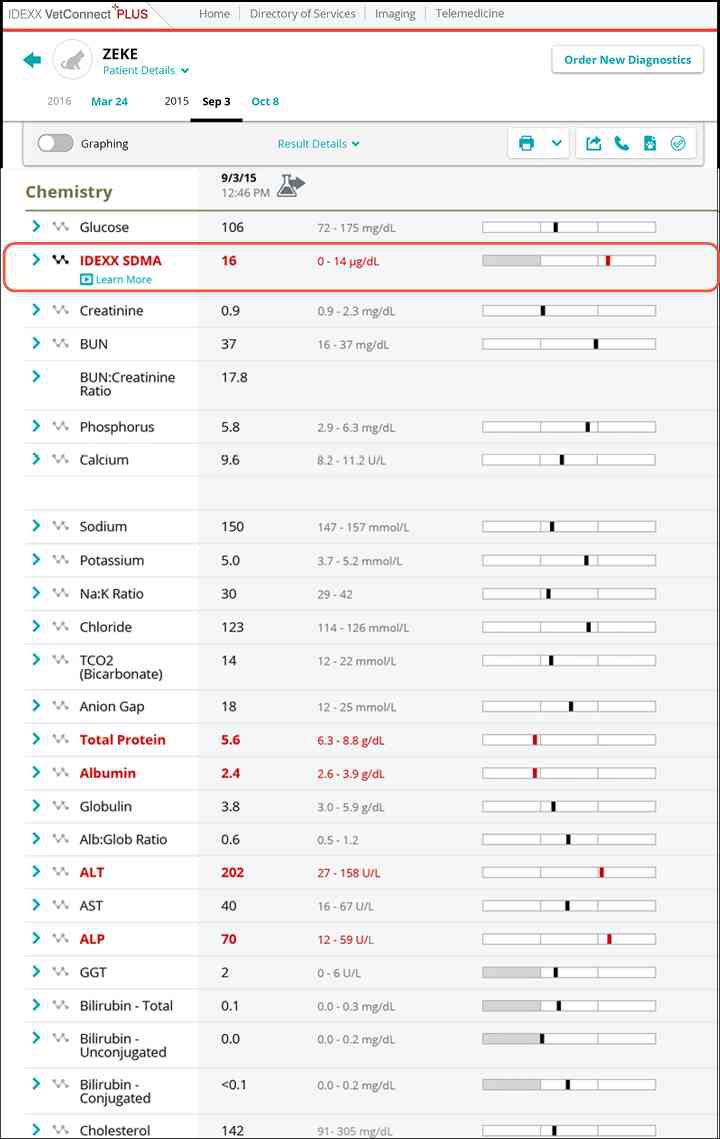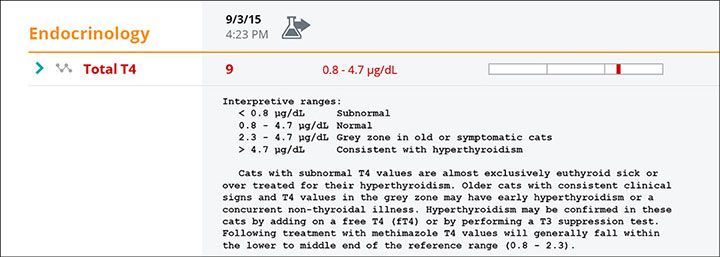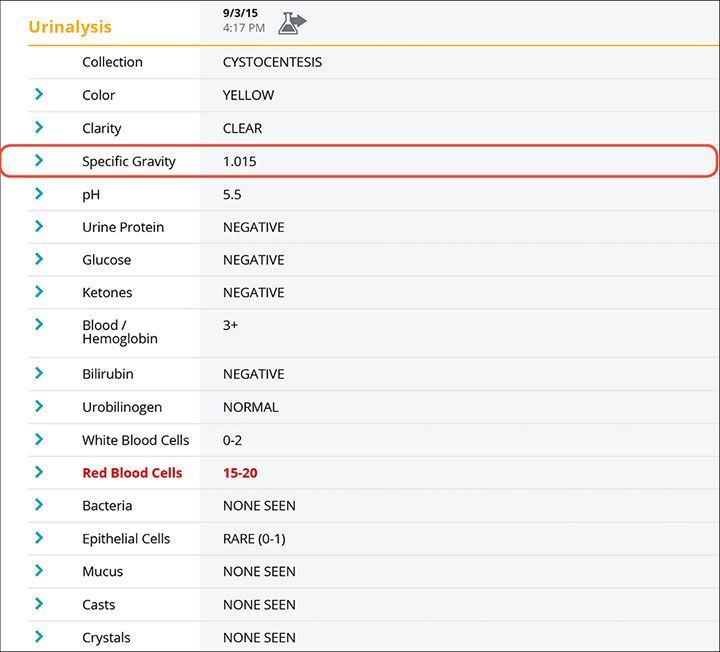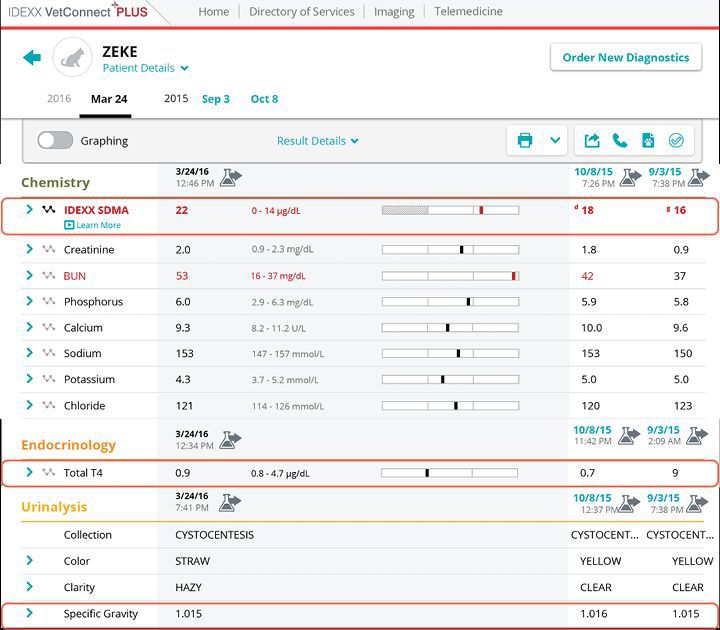IDEXX SDMA
SDMA Case Study: Zeke
SDMA helps unmask chronic kidney disease in a hyperthyroid cat

Background information
Name: Zeke
Age: 14 years
Breed: Domestic shorthair
Gender: Male
Presenting reason and history
Zeke’s owners were concerned that he seemed to be eating a lot but losing weight. They also noticed him drinking and urinating more and meowing more than he usually does. His owners said he seemed to be active, but they were concerned that his habits at home were not normal for him.
Physical examination
Zeke was thin with a low body condition score (BCS) of 2.5 on 9-point scale. He had moderate dental
disease, a rapid heart rate and a palpable nodule in his neck area.
Diagnostic plan
Complete blood count (CBC); chemistry panel, including the IDEXX SDMA Test and electrolytes; complete urinalysis; and total T4 were recommended. Zeke’s CBC results were within normal limits. Other findings are shown below.
Diagnostic review
- Based on history, physical examination and laboratory results, Zeke was diagnosed with hyperthyroidism.
- Increased SDMA* result guides us to investigate further – chronic kidney disease (CKD) is a progressive disorder that may exist alongside other medical conditions. While attention to the hyperthyroid condition was a medical priority, based on the diagnostics performed, the kidneys required investigation and support as well.
- Possible further diagnostic investigation – thoracic and abdominal imaging can help confirm and assess the medical conditions identified within the blood and urine diagnostics as well as other organ system impact (e.g., heart). An electrocardiogram would assess cardiac conductivity. Measurement of blood pressure was encouraged, as both kidney disease and hyperthyroidism are associated with high blood pressure.
Diagnosis and case follow-up
-
Hyperthyroidism successfully treated with I-131 and concurrent International Renal Interest Society (IRIS) CKD Stage 2 disease.
-
One month following treatment with I-131, Zeke’s total T4 level was at 0.7 μg/dL, his SDMA was measured at 17 μg/dL, and his creatinine increased from 0.9 to 1.8 mg/dL. His urine remained poorly concentrated, with specific gravity of 1.014.
-
SDMA continues to indicate issues with kidney function, even though creatinine is within normal limits.
-
Zeke did not return to his veterinarian for several months, but a recheck of his lab work at that time confirmed that his hyperthyroidism had been successfully treated. He continued to have an increased SDMA, a normal creatinine and dilute urine.
-
Following the IRIS CKD Staging Guidelines, Zeke has IRIS CKD Stage 2 disease. Without SDMA, his CKD would have gone undiagnosed. Zeke’s veterinarian followed the IRIS CKD Treatment Guidelines to treat him, which could help delay the progression of Zeke’s CKD and even extend his life.
Patient reports
Chemistry

Total T4

Urinalysis

Follow-up laboratory results

Discussion
Zeke’s case reinforces that SDMA is more reliable than creatinine as a biomarker of kidney health.1–5 In this particular example of its reliability, SDMA held true to the indication of kidney disease, while creatinine fell victim to the influence of both metabolism and body mass.
Both kidney disease and hyperthyroidism are common medical conditions in older cats. Further challenging the reliability of creatinine in this case was the concurrent hyperthyroidism, which increases metabolism and artificially increases glomerular filtration rate (GFR). The concurrent conditions in this case revealed the shortcomings of creatinine, whereas influence on SDMA by hyperfiltration is only slightly blunted6 because of SDMA’s sensitivity for detecting kidney disease earlier and the fact that it is not influenced by other factors like muscle mass.4–5
Why SDMA matters
Click the portraits to see how acting on IDEXX SDMA Test results helped Reese, Molly, Bess, Jimmy, Mary Jane, Scarlet and Zeke.
*Symmetric dimethylarginine.
References
- Hall JA, Yerramilli M, Obare E, Yerramilli M, Yu S, Jewell DE. Comparison of serum concentrations of symmetric dimethylarginine and creatinine as kidney function biomarkers in healthy geriatric cats fed reduced-protein foods enriched with fish oil, L-carnitine and medium-chain triglycerides. Vet J. 2014;202(3):588-596.
- Hall JA, Yerramilli M, Obare E, Yerramilli M, Melendez LD, Jewell DE. Relationship between lean body mass and serum renal biomarkers in healthy dogs. J Vet Intern Med. 2015;29(3):808-814.
- Nabity MB, Lees GE, Boggess M, et al. Symmetric dimethylarginine assay validation, stability and evaluation as a marker for early detection of chronic kidney disease in dogs. J Vet Intern Med. 2015;29(4):1036-1044.
- Hall JA, Yerramilli M, Obare E, Yerramilli M, Jewell DE. Comparison of serum concentrations of symmetric dimethylarginine and creatinine as kidney function biomarkers in cats with chronic kidney disease. J Vet Intern Med. 2014;28(6):1676-1683.
- Hall JA, Yerramilli M, Obare E, Yerramilli M, Almes K, Jewell DE. Serum concentrations of symmetric dimethylarginine and creatinine in dogs with naturally occurring chronic kidney disease. J Vet Intern Med. 2016;30(3):794-802.



